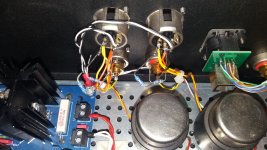I also don't understand why there is so much less bass with Cinemag transformers compared to capacitor....
Just to be SURE: did you connect the transformer primaries from POS to NEG or from POS to ZERO (or NEG to ZERO) on the DDDAC board?
Yes, but i will try to reverse one of them to check. Primary winding connection is +out red wire and -out brown wire. On the secondary winding, yelow is +out and orange is - out. Black and white (housing and screen) are connected to the chassis. You can see it all in the picture I posted.
Last edited:
Ok, then run some sine waves through your DDDAC and use your scope to check what they look like at the transformer secondaries.
Obviously I have to check everything, the frequency range and polarity of the transformers. If Doede says this is a unique case, then something is definitely not right.
I would really like to keep the transformers, but also that it sounds better than capacitors.
I would really like to keep the transformers, but also that it sounds better than capacitors.
Last edited:
Last night I had some time to check the phase on the transformers. Turning the phase on one of the transformers leads to complete loss of bass and stereo image. After that I reconnected the transformer properly and tried again the various resistors on the secondary, but without progress. I'll see what the measurement says, but I think this is a hopeless case as far as these Cinemag output transformers are concerned.
Attachments
Last edited:
I see you have the XLR and RCA wired in parallel with both having resistor loading so I assume you have considered that in your resistor calculations?
The resistors are parallel to the secondary windings, one resistor to one secondary. In that picture, two resistors are connected and two are not. The RCA is connected to the XLR as recommended (+ out to central pin, - out to GND of the RCA). The RCA is isolated from the chassis. I connected the resistors to the XLR connectors because it's more convenient than to the RCA. It’s all well connected, I tried it without a resistors too. The higher the resistance connected, the sound is brighter.
Last edited:
Hello,
It could probably be just a tiny mistake that causes things not to work.
Maybe post some more close up pictures or search for close up pictures posted by people using the same transformers.
Maybe Doede himself will easily notice what is wrong in your DDDAC after you added some more pics.
Greetings, eduard
It could probably be just a tiny mistake that causes things not to work.
Maybe post some more close up pictures or search for close up pictures posted by people using the same transformers.
Maybe Doede himself will easily notice what is wrong in your DDDAC after you added some more pics.
Greetings, eduard
I did a few measurements over the weekend. I used an online function generator (it is limited to 20Hz-20KHz), the connection is via USB cable, resolution 24bit 192kHz, RCA outputs. USB Osciloscope: HANTEK 6254BD.
1: Friends DAC (2 boards) with Cinemag 600/600 transformers at the output, load 18k resistor at secondary.
1: Friends DAC (2 boards) with Cinemag 600/600 transformers at the output, load 18k resistor at secondary.
Attachments
-
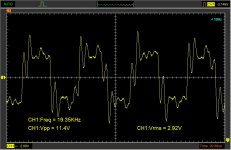 Cinemag 18K 20KHz SQ.jpg140.4 KB · Views: 127
Cinemag 18K 20KHz SQ.jpg140.4 KB · Views: 127 -
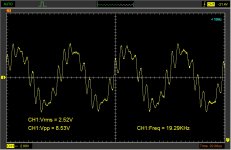 Cinemag 18K 20KHz SIN.jpg139.9 KB · Views: 116
Cinemag 18K 20KHz SIN.jpg139.9 KB · Views: 116 -
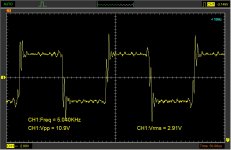 Cinemag 18K 5kHz SQ.jpg121.7 KB · Views: 118
Cinemag 18K 5kHz SQ.jpg121.7 KB · Views: 118 -
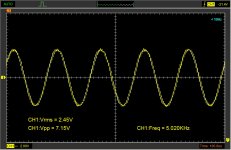 Cinemag 18K 5KHz SIN.jpg138.4 KB · Views: 121
Cinemag 18K 5KHz SIN.jpg138.4 KB · Views: 121 -
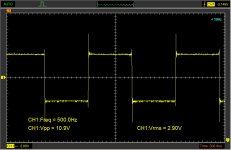 Cinemag 18K 500Hz SQ.jpg107.3 KB · Views: 123
Cinemag 18K 500Hz SQ.jpg107.3 KB · Views: 123 -
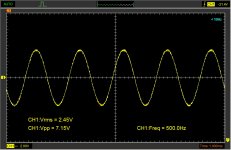 Cinemag 18K 500Hz SIN.jpg132.3 KB · Views: 123
Cinemag 18K 500Hz SIN.jpg132.3 KB · Views: 123 -
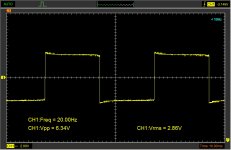 Cinemag 18K 20Hz SQ.jpg104.5 KB · Views: 266
Cinemag 18K 20Hz SQ.jpg104.5 KB · Views: 266 -
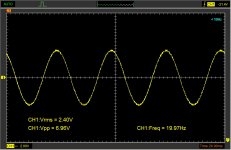 Cinemag 18K 20Hz SIN.jpg126.2 KB · Views: 269
Cinemag 18K 20Hz SIN.jpg126.2 KB · Views: 269 -
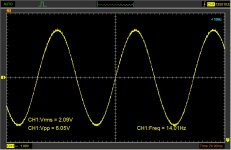 Cinemag 2K 14Hz SIN.jpg134 KB · Views: 264
Cinemag 2K 14Hz SIN.jpg134 KB · Views: 264 -
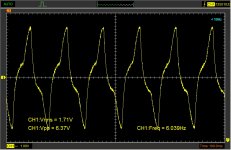 Cinemag 18K 6Hz SIN.jpg157.2 KB · Views: 276
Cinemag 18K 6Hz SIN.jpg157.2 KB · Views: 276
Last edited:
2: Friends DAC with Cinemag 600/600 transformers at the output, load 2k resistor at secondary.
Attachments
-
 Cinemag 2K 20KHz SQ.jpg138.5 KB · Views: 130
Cinemag 2K 20KHz SQ.jpg138.5 KB · Views: 130 -
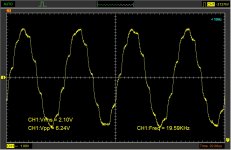 Cinemag 2K 20KHz SIN.jpg138.3 KB · Views: 121
Cinemag 2K 20KHz SIN.jpg138.3 KB · Views: 121 -
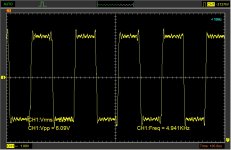 Cinemag 2K 5KHz SQ.jpg132.2 KB · Views: 128
Cinemag 2K 5KHz SQ.jpg132.2 KB · Views: 128 -
 Cinemag 2K 5KHz SIN.jpg151.9 KB · Views: 110
Cinemag 2K 5KHz SIN.jpg151.9 KB · Views: 110 -
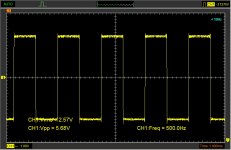 Cinemag 2K 500Hz SQ.jpg119.8 KB · Views: 122
Cinemag 2K 500Hz SQ.jpg119.8 KB · Views: 122 -
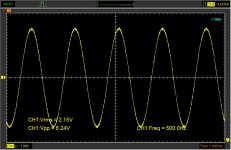 Cinemag 2K 500Hz SIN.jpg155.1 KB · Views: 116
Cinemag 2K 500Hz SIN.jpg155.1 KB · Views: 116 -
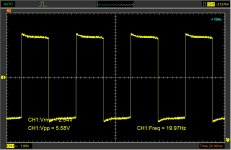 Cinemag 2K 20Hz SQ.jpg114.1 KB · Views: 131
Cinemag 2K 20Hz SQ.jpg114.1 KB · Views: 131 -
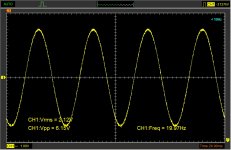 Cinemag 2K 20Hz SIN.jpg145.2 KB · Views: 136
Cinemag 2K 20Hz SIN.jpg145.2 KB · Views: 136
Last edited:
3. My DAC (4 boards) with Jantzen Silver Z 4,7uF capacitors at the output, load 18k resistor.
Attachments
-
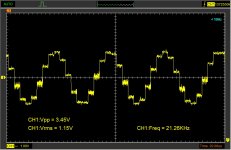 NIXIE 18K 20KHz SIN.jpg128.9 KB · Views: 133
NIXIE 18K 20KHz SIN.jpg128.9 KB · Views: 133 -
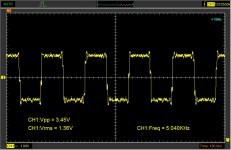 NIXIE 18K 5KHz SQ.jpg129.6 KB · Views: 135
NIXIE 18K 5KHz SQ.jpg129.6 KB · Views: 135 -
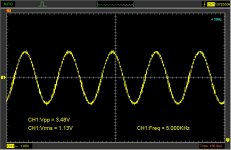 NIXIE 18K 5KHz SIN.jpg140.9 KB · Views: 120
NIXIE 18K 5KHz SIN.jpg140.9 KB · Views: 120 -
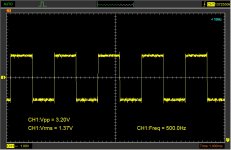 NIXIE 18K 500Hz SQ.jpg119.9 KB · Views: 130
NIXIE 18K 500Hz SQ.jpg119.9 KB · Views: 130 -
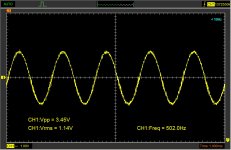 NIXIE 18K 500Hz SIN.jpg137.4 KB · Views: 314
NIXIE 18K 500Hz SIN.jpg137.4 KB · Views: 314 -
 NIXIE 18K 20Hz SQ.jpg118.4 KB · Views: 315
NIXIE 18K 20Hz SQ.jpg118.4 KB · Views: 315 -
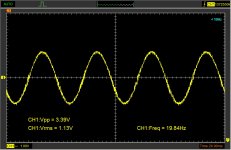 NIXIE 18K 20Hz SIN.jpg130.4 KB · Views: 314
NIXIE 18K 20Hz SIN.jpg130.4 KB · Views: 314 -
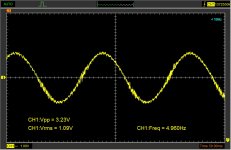 NIXIE 18K 5Hz SIN.jpg123.3 KB · Views: 314
NIXIE 18K 5Hz SIN.jpg123.3 KB · Views: 314 -
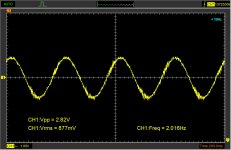 NIXIE 18K 2Hz SIN.jpg127 KB · Views: 316
NIXIE 18K 2Hz SIN.jpg127 KB · Views: 316 -
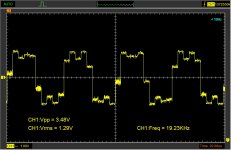 NIXIE 18K 20KHz SQ.jpg127.8 KB · Views: 129
NIXIE 18K 20KHz SQ.jpg127.8 KB · Views: 129
Last edited:
Listening test:
1. Cinemag with 18K load, too bright, subjectively less bass, (measurement shows some overshoot and ringing, maybe that's the reason?). The sine signal is distorted below aprox. 14Hz.
2. Cinemag with 2K load, the bass is in proportion to the rest of the spectrum, but the sound is flat and details are misssing. It is obvious from the measurement that the 2K load is suitable for this transformer, only the sound is not right.
3. Jantzen capacitors at the output sounds great, and that will be put instead of Cinemags.
I still have to try Cinemags on my 4 board DAC. If 4 boards turn out to be the solution for Cinemag, then I will advise a friend to buy 2 more boards.
In the meantime, while I wait for the capacitors, I will re-wire the DAC with better cables.
Thanks to everyone for the advice, the listening test decided in this case.
1. Cinemag with 18K load, too bright, subjectively less bass, (measurement shows some overshoot and ringing, maybe that's the reason?). The sine signal is distorted below aprox. 14Hz.
2. Cinemag with 2K load, the bass is in proportion to the rest of the spectrum, but the sound is flat and details are misssing. It is obvious from the measurement that the 2K load is suitable for this transformer, only the sound is not right.
3. Jantzen capacitors at the output sounds great, and that will be put instead of Cinemags.
I still have to try Cinemags on my 4 board DAC. If 4 boards turn out to be the solution for Cinemag, then I will advise a friend to buy 2 more boards.
In the meantime, while I wait for the capacitors, I will re-wire the DAC with better cables.
Thanks to everyone for the advice, the listening test decided in this case.
Last edited:
The measurements show that both the Cinemag (with 2k load) and the capacitor output look about right. Response is flat from 20 Hz to 20 kHz.
How did you measure this? Was the Cinemag secondary (or the caps) connected to the (pre)amplifier or not?
I am not sure about the winding ratio of the Cinemag, but the Cinemag measurements show higher output voltage than with the caps. Did you connect the caps in balanced or single ended mode?
How did you measure this? Was the Cinemag secondary (or the caps) connected to the (pre)amplifier or not?
I am not sure about the winding ratio of the Cinemag, but the Cinemag measurements show higher output voltage than with the caps. Did you connect the caps in balanced or single ended mode?
Cinemag was directly connected to the probe of the oscilloscope, without a preamplifier (only 2K load at secondary).
Cinemag transmission ratio is 1:1, except that Cinemag uses + and - out to RCA, and capacitors uses only + out and common (GND). That's why the output voltage is twice as high for Cinemag.
Capacitors cannot be used with + and - out for RCA, only for XLR, but Cinemag can.
Cinemag transmission ratio is 1:1, except that Cinemag uses + and - out to RCA, and capacitors uses only + out and common (GND). That's why the output voltage is twice as high for Cinemag.
Capacitors cannot be used with + and - out for RCA, only for XLR, but Cinemag can.
Last edited:
Can you repeat the measurements while the DDDAC output is connected to the preamp?
Capacitors can be used for balanced output, if the preamp has a balanced input. I guess your preamp has single ended input?
Capacitors can be used for balanced output, if the preamp has a balanced input. I guess your preamp has single ended input?
I see no reason to repeat the measurement. My SS preamp has an input resistance of 50K, tube preamp 100K, that will have little effect on the measurements. There is a possibility that the capacity of the interconnect cable has some impact, but also small. The interconnects are VDH D102 MK3, 70cm long. I can add a capacity of 100pF to RCA connector when measuring. Unfortunately I only have SE premps.
Last edited:
The 2k load is doing a better job of terminating the transformers. It would probably work better driven by a 4 board dac where the output Z is lower than 100ohms. 2.12volts at 20hz is pretty flat response compared to 2.15 at 500hz. No bass roll off.
Are you using any output filter capacitors across the dac output resistors? I’ve always wondered if that makes a significant change in the HF sine wave waveforms.
Are you using any output filter capacitors across the dac output resistors? I’ve always wondered if that makes a significant change in the HF sine wave waveforms.
Do you have any DC offset between your + and- outputs? It should be very low, only a few mv. Some transformers cannot tolerated even a small offset. The output does not show any signs of gross distortion caused by saturation of the core, but you might want to contact cinemag and see if the offset levels you measure are of any concern.
I did not check the DC offset at the outputs. I'll check that too. The problem is that I have already removed all the wiring so now I can't measure anything until I put it back into function.
I do not use capacitors across DAC output resistors . Why would I use them?
I do not use capacitors across DAC output resistors . Why would I use them?
Last edited:
No need to use capacitors for balanced output if you use the transformer. You may or may not be able to get away without caps for balanced when directly connecting the DAC outputs to an amp. It depends on the input circuitry of the amp. The one caveat is that some transformers are not designed to handle DC. Small input transformers in particular are easy to saturate by putting dc on the windings. You can still measure the offset between + and - outputs without re installing the transformers. Once you have those numbers you can contact cinemag and ask them if it is an issue.
- Home
- Source & Line
- Digital Line Level
- A NOS 192/24 DAC with the PCM1794 (and WaveIO USB input)
